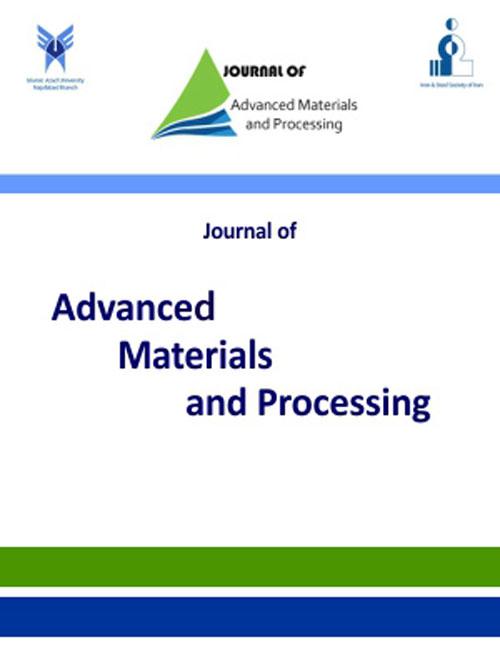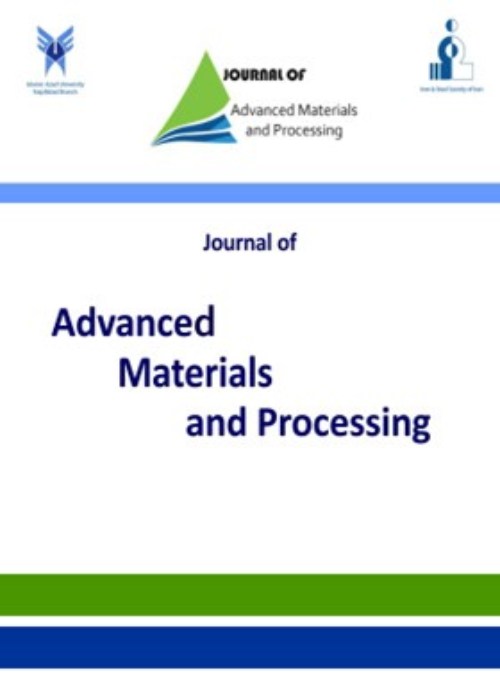فهرست مطالب

Journal of advanced materials and processing
Volume:5 Issue: 4, Autumn 2017
- تاریخ انتشار: 1396/08/26
- تعداد عناوین: 7
-
-
Pages 3-11The quality of machined workpieces, particularly precious metals, is the main goal of every machining process. A suitable cutting fluid can substantially affect the machining outcome. The present study is novel in that it uses nanofluids in the machining process to mitigate the adverse effects of high temperatures and fraction. Graphene oxide (GO) nanoparticles were synthesized using the modified Hummers method. FTIR, FESEM and XRD tests were used for GO characterization and also for atomic, surface and chemical analyses. The studied workpiece was a bronze shaft, ⌀20 mm. Different nanofluid solutions (0.25 and 0.5 vol%) were applied to reduce the machining loads and increase the workpiece flatness. The results were then compared with those from a base water-oil (90-10 vol%) cutting fluid (Behran, Iran). The NP characterization confirmed the satisfactory quality of the particles. It also showed that the effect of NP on the machining forces is substantial. Accordingly, the largest reduction in the mean machining force was achieved when using the 0.5% nanofluid solution (28.34% less than the base fluid). The surface roughness of the bronze shaft was lower when using the 0.5% nanofluid (0.57 μm) instead of the base fluid (0.668 μm). Finally, it can be concluded that this nanofluid can be an alternative to the base fluids in the machining process.Keywords: Empirical Analysis, Nanoparticle synthesis, Graphene Oxide, Machining process, Bronze
-
Pages 12-19This paper reports the synthesis of nanostructured copper aluminate powders and their efficient application as a potential photocatalysts for photodegradation of organic dyes. The synthesized nanocomposites powders were characterized by XRD, TEM, DTA-TG analysis and UV-Vis spectroscopy. XRD results showed that pure and single phase copper aluminate was obtained after calcination at 700 °C. The obtained powders had a layered structure and each layer was composed of many nanoparticles which were inter connect to each other. The average particle size of samples calcined at 700 °C was about 26 nm. The photocatalytic activity of the prepared nanocatalysts was investigated via photodegradation of methyl orange under UV light. The band gap energy values of CuAl2O4 calcined at 700 and 900 °C are 1.79 and 1.72 eV, respectively. The results showed that the samples calcined at 700 °C showed the highest activity with 95 % photodegradation efficiency for degradation of methyl orange dye.Keywords: Nanostructure, Photocatalyst, Copper aluminate, Polyacrylamide
-
Pages 20-28In this paper, we present nonlinear buckling instability analysis of Polystyrene, Polyvinyl chloride, and Polypropylene nano-composite shell-structures reinforced by carbon nanotubes (CNTs) under uni-axial compressive load to obtain a more conservative buckling response as compared with linear analysis. For this end, the Mori-Tanaka method is firstly utilized to estimate the effective elastic modulus of composites having aligned oriented straight CNTs. Then, a novel model based on micro-mechanics and finite element method is developed for buckling analysis of a cylindrical nano-composite shell reinforced by CNTs and various effects of different types of polymer matrices (Polystyrene, Polyvinyl chloride, and Polypropylene), CNTs volume fraction, CNTs orientation angle, aspect ratio of cylinder, and different boundary conditions (simply supported and clamped ends) on critical buckling load of cylindrical nano-composite shells are discussed. The proposed model is based on Mori-Tanaka micro-mechanics which is developed in ABAQUS finite element package. Herein, numerical results show different behavior from shell-type buckling to beam-type buckling in L/R =8 due to change of the cylinder’s aspect ratios. Moreover, the developed finite element code and numerical results are compared and validated with Mori-Tanaka analytical model in available literature and shown a good agreement.Keywords: Buckling, polymer nano-composite, carbon nanotube, cylindrical shell, finite element method
-
Pages 21-33Pure and VO2+ doped poly(vinyl chloride) (PVC) films were prepared by using solution casting method. Various techniques including Differential Scanning calorimetry(DSC), Thermogravimetric analysis (TGA), Fourier transform infrared spectroscopy (FTIR), Ultraviolet-visible spectroscopy(UV-Vis) and Electro paramagnetic resonance(EPR) were employed in the characterization of the samples. The thermal properties of these films were investigated by employing DSC and TGA. Using the DSC thermograms, glass transition temperature (Tg) and melting temperature (Tm) of PVC films were measured. Thermogravimetric curves of pure and VO2+ doped PVC films showed three distinct steps of weight loss. FTIR results show that the addition of VO2+ reduces the crystallinity of PVC due to the interaction of vanadium ions with the CH stretching modes of the CH2 groups. Optical absorption edge and indirect band gap showed a decreasing trend with increasing VO2+ concentration. From the EPR spectra, the Spin – Hamiltonian parameters (g and A) were evaluated. For dielectric studies films were studied in the frequency range from 10 KHz to 2 MHz at room temperature. It is observed that with the increase in frequency, the value of dielectric constant decreases up to100 kHz, thereafter it becomes almost constant for all the samples.Keywords: Poly(Vinyl Chloride), DSC, TGA, Optical analysis, EPR
-
Pages 34-42Aluminum alloys have many applications in transportation industry because of their abundance, ease of production, as well as proper mechanical and physical properties. One of these alloys is obtained by combining aluminum with silicon and magnesium (Al-Mg-Si alloys). Since the plates of this alloy are rolled up, heat transfer and crystallization in the heat-affected zone (HAZ) is an important point in their welding. In this study, we have attempted to investigate welding-induced recrystallization in this alloy using the finite element method. For this purpose, the physics of the problem was defined and simulated using ANSYS software. In the next step, the results of theoretical (simulated) and experimental investigations were compared and the effect of current on the size of weld pool and thermal cycle of different samples was assessed. Then, through microscopic examination of different areas of the welded samples, the size of recrystallized area was measured and compared with the results of mathematical calculations. Finally, the hardness of weld zone and recrystallized area was analyzed. A temperature of 630°C and holding time of about 0.3 seconds is sufficient for recrystallization of this alloy during welding.Keywords: Heat Transfer, Recrystallization, TIG Welding, Aluminum 6070, Finite Element Method
-
Pages 43-53Equal channel angular pressing has been among prominent part of procedures employed for the fabrication of the ultrafine-grained structures of various severe plastic deformation techniques. The objective of this paper was to experimentally investigate the influence of the process in the two rotational routes A and Bc on the mechanical properties of Al 5086 alloy. Specimens were processed up to 10 passes at 150 ºC in a die with 120º internal angle. To evaluate the mechanical properties, uni-axial tensile and hardness tests were performed on the specimens. The results showed that in all passes, the route Bc had a higher effect on the simultaneous improvement of strength, elongation, and hardness. Investigation of the fracture surface using Scanning Electron Microscopy revealed that increasing the number of passes led to raising the number of dimples and the better distribution of them for both routes. The textures were also studied using the X-ray diffraction patterns. The results showed the dominant texture was altered from (111) to (220) plane by increasing the number of passes through both routs.Keywords: Al 5086 alloy, ECAP, A, Bc rotation routes, Mechanical properties, Fracture surface
-
Pages 56-65Nanostructured NiSb2O6 samples were synthesized via solid state reactions at the reaction temperatures of 600, 700 and 800 °C using Sb2O3, Ni(CH3COO)2.2H2O and Ni(NO3)2.6H2O as raw materials. Parameters of reaction temperature and raw materials types were investigated for the crystal phase growth study. The synthesized nanomaterials were characterized by X-ray powder diffraction (XRPD) technique, fourier-transform infrared (FTIR) spectroscopy. Brunauer–Emmett–Teller (BET) and Barrett-Joyner-Halenda (BJH) methods were used to investigate the textural properties of the obtained samples. Rietveld analyses showed that the obtained materials were crystallized well in the tetragonal crystal structure with the space group of P42/mnm. The lattice parameters of the targets were about a = b = 4.64 Å and c = 9.22 Å. The data revealed that the crystal phase purity of the as-synthesized nanomaterials was increased with increasing the reaction temperature from 600 to 800 °C. Besides, the data indicated that the synthesis reactions using Ni(NO3)2.6H2O generated a better crystalline growth and purity compared to Ni(CH3COO)2.2H2O raw material in a certain reaction temperature. The morphologies of the synthesized materials were studied by field emission scanning electron microscopy (FESEM) technique. The FESEM images showed that the homogeneity of the synthesized powder was improved when Ni(NO3)2.6H2O was used as raw material. Ultraviolet-visible spectra showed that the synthesized NiSb2O6 nanomaterials had strong light absorption in the ultraviolet light region. The calculated direct optical band gaps tendency showed that the band gaps were increased with increasing the reaction temperature.Keywords: NiSb2O6, Solid state Method, Nanomaterial, Rietveld


